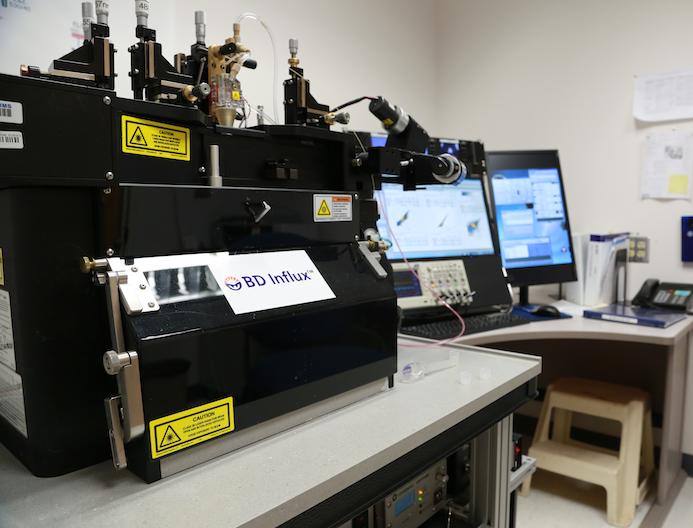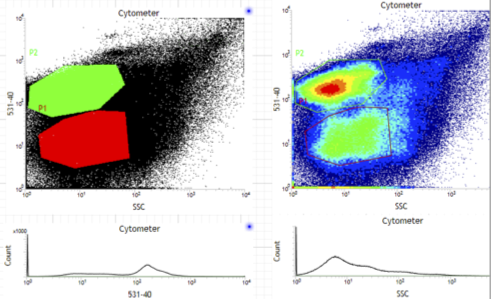Flow Cytometry
Flow cytometers analyze one particle at a time by using a laser to excite the particle with a specific wavelength of light, and then quantifying the resulting light scattered by and fluoresced from that particle. These basic light signals are then used to investigate inherent particle characteristics such as size, shape, or pigment composition. Extensive additional parameters can be elucidated with fluorescent stains. Flow cytometers can also be used to define which particles will be sorted out of the sample stream for subsequent analysis (e.g. mass spectometry, genomics).

The Facillity
Here at the VIMS Flow Cytometry Facility, we have a BD Influx flow cytometer that can meet all of your sorting needs. This cell sorter is incredibly fast, boasting a practical throughput of 20,000 events/second, and is able to maintain high purity of sorted particles. The instrument’s open and modular configuration makes it easily adaptable for multiple users and functions. The facility maintains multiple nozzle sets, sheath tanks, and fluidics lines to eliminate cross contamination between samples (e.g. live, dead, natural abundance isotopes, etc.).
Lasers The instrument has three application-specific detection modules based on excitation by solid state lasers. The fundamental workhorse of the system is a blue laser (488nm 200mW) for analyzing chlorophyll and common fluorescent stains like SYBR Green, fluoroscein isothiocyanate, and propidium iodide. A blue-violet laser (457nm 300mW) allows for measurements of primary chlorophyll and help discriminate multiple-stain experiments using cyan fluorescent protein. Lastly, an ultraviolet laser (355nm 100mW) would be used to identify cells with DNA stains like DAPI and Hoechst, and has the added benefit of being able to excite quantum dots.

Particle Detection & Sorting The Influx has 13 PMTs for measuring emission parameters, including a small particle detector that improves forward scatter detection, which allows analysis of particles as small as 200nm, critical for marine science applications. The sorting module allows up to 4-way sorting, with proportional and positional sort modes. With a computerized deposition unit, the Influx is designed for sorting into a variety of common vessels, including slides, tubes, 96-well plates, or even custom devices.
Laboratory In the lab where the Influx is located, there is a benchtop, Eppendorf pipettes, an analytical balance, and dissecting microscope. Across the hall there is Milli-Q (18.2 Ω) water and a hood available for use. There is dedicated freezer space (both -20 and -80°C) to store your samples.
Expertise The VIMS cytometer facility boasts a dedicated technician and lab space, with access to expertise in diverse fields such as biogeochemistry, genetics, and plankton phylogeny.
Want to use this state-of-the art instrument for your high-speed sorting needs?
Please fill out the usage request form.
For more information contact:
Quinn Roberts (qroberts@vims.edu)Technical Director, VIMS Flow Cytometry Facility
or
Deborah Bronk (bronk@vims.edu)
Director, VIMS Flow Cytometry Facility
